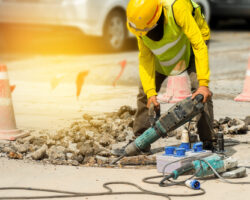Tips for Using Jackhammers Properly
 Jackhammers are powerful tools commonly used in construction and demolition projects. They are efficient at breaking through tough surfaces such as concrete, asphalt, and rock. However, operating a jackhammer requires proper technique and safety measures to ensure a successful and injury-free experience. In this blog post, we will provide some valuable tips for using jackhammers properly.
Jackhammers are powerful tools commonly used in construction and demolition projects. They are efficient at breaking through tough surfaces such as concrete, asphalt, and rock. However, operating a jackhammer requires proper technique and safety measures to ensure a successful and injury-free experience. In this blog post, we will provide some valuable tips for using jackhammers properly.
1. Safety First: Personal Protective Equipment (PPE)
Before starting any work with a jackhammer, it is crucial to prioritize your safety by wearing the appropriate Personal Protective Equipment (PPE). Always remember to wear safety goggles or a face shield to protect your eyes from flying debris, as well as a face mask to minimize dust inhalation. Additionally, wear earplugs or earmuffs to protect your hearing from the loud noise generated by the jackhammer.
Furthermore, sturdy work gloves and steel-toed boots are essential to protect your hands and feet from potential injuries caused by the machine or falling debris. Do not start using a jackhammer without wearing the necessary PPE.
2. Familiarize Yourself with the Jackhammer
Before using a jackhammer, take the time to familiarize yourself with its various features, controls, and attachments. Read the manufacturer’s instructions and guidelines carefully. Understand how to properly start and stop the machine, adjust the speed and intensity of the impact, and change the chisels or bits as needed.
Knowing how to operate the jackhammer correctly will not only improve your efficiency but also prevent accidents or damage to the equipment.
3. Proper Body Positioning and Stance
When using a jackhammer, your body positioning and stance play a crucial role in maintaining control and reducing fatigue. Stand with your feet shoulder-width apart and maintain a stable stance. Keep your knees slightly bent and distribute your weight evenly between both legs. This will help you maintain balance and absorb some of the vibration generated by the jackhammer.
Additionally, position your body in a way that allows you to have a firm grip on the handles of the tool. This will give you better control over the jackhammer, reducing the risk of it slipping or jerking unexpectedly.
4. Start with Light Pressure and Gradually Apply More
It’s important to start with light pressure when using a jackhammer and gradually apply more force as needed. Let the weight of the machine do most of the work. Pushing too hard or applying excessive downward force can lead to unnecessary wear on the jackhammer and may cause it to bounce or recoil, potentially causing injury.
By starting with light pressure, you can also gauge the force required to penetrate the surface without damaging underlying structures or causing unintended vibrations.
5. Use the Correct Chisel or Bit
Different surfaces require different chisels or bits for optimal performance. Using the wrong tool can reduce your efficiency and potentially damage the jackhammer or the surface you’re working on. Refer to the manufacturer’s recommendations or consult with a professional to determine the appropriate chisel or bit for your specific application.
Make sure to securely attach the chisel or bit to the jackhammer before starting work. Loose or improperly secured attachments can cause accidents or create unnecessary vibrations.
6. Plan Your Work and Keep a Steady Pace
Before using a jackhammer, plan your work to ensure efficiency and safety. Identify the areas that need to be broken and create a strategy for maximizing productivity. Work in a methodical manner, starting from the edges and gradually moving towards the center.
Maintain a steady pace, neither too fast nor too slow. Rushing can lead to mistakes, while going too slowly can result in wasted time and unnecessary fatigue. Find a rhythm that allows you to maintain control and break through the surface effectively.
7. Take Regular Breaks to Prevent Fatigue
Jackhammer operation can be physically demanding, causing fatigue to set in quickly. It is important to take regular breaks to rest and allow your body to recover. Frequent breaks can help prevent muscle strain, reduce the risk of accidents due to fatigue, and improve overall performance.
Hydration is also crucial during breaks. Remember to stay properly hydrated by drinking water or sports drinks to replenish the fluids your body loses through sweating.
Conclusion
Proper usage of a jackhammer requires adherence to safety measures, familiarity with the machine, correct body positioning, using the appropriate attachments, and planning your work effectively. By following these tips, you can maximize efficiency, prevent accidents, and improve your overall jackhammer experience. Always prioritize safety and seek professional guidance if you are unsure about the proper usage of the equipment.
Got Questions? Let Us Help!
Welcome to Ram Rent-All, Inc. If you are looking for quality equipment, look no further. We are your one-stop solution for all of your equipment rental needs. We have a huge selection of equipment to choose from, from lawn and garden tools to construction necessities. Options include air compressors, Bobcats, forklifts, generators, tractors, water pumps, mixers, light towers, pressure washers, and more! If you’re going to do a job yourself, you want the best tools, and we can supply them to you at a reasonable price, without the need for costly contractors or direct purchases. Call us today!
